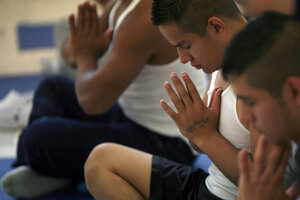Meditating behind bars: How yoga in prisons could cut overcrowding
Yoga can teach prisoners the self-control and self-discipline that they never learned as youths.

Inmates practice yoga during class inside a juvenile detention center in Mexico City. Yoga can reduce stress, violence, and addiction, and increase self-control, among both female and male inmates.
Carlos Jasso/Reuters
Earlier this year the Supreme Court ruled that state of California prisons were so bad as to be inhumane, violating the 8th amendment prohibiting cruel and unusual punishment.
The reason? Overcrowding. California must to reduce its prison population by 30,000 prisoners, according to the ruling.
Overcrowding is a perennial issue in US prisons in no small part because the recidivism rate is remarkably high. In 1994 the largest study of prisoner recidivism ever done in the United States showed that, of nearly 300,000 adult prisoners who were released in 15 different states, 67.5 percent were re-arrested within three years.
James Fox, who founded the nonprofit Prison Yoga Project, has been working with incarcerated youth and adults for more than 10 years and has some ideas on what keeps the recidivism rate above 50 percent. In his opinion, the prison system overly emphasizes retributive justice – that punishment alone is a sufficient response to a crime. Fox is an advocate for restorative justice, an approach that focuses on criminals as individuals with needs and seeks to find ways to empower them to meet those needs, and thinks an emphasis on restorative justice could lower the recidivism rate.
Fox teaches yoga to male prisoners as a form of restorative justice. Criminals, and especially repeat offenders, he told Dowser, are suffering from unresolved trauma from their early years, and stunted emotional intelligence. “The men that I work with didn’t get proper guidance when they were in adolescence, never dealt with core social and emotional issues of that age – they rebelled instead, or got locked up at an early age,” he explained.
Yoga and meditation help prison inmates develop important emotional skills like impulse control and willpower – both of which can prevent someone from seeking out a drug fix or pulling out a weapon in moments of stress, said Fox.
“It’s so important for teaching yoga in prison to make it practical, applicable to issues that prisoners face,” explained Fox, reflecting on his decade of teaching yoga in places like San Quentin in California, the country’s largest prison. (San Quentin has an official capacity of around 3,000 people, but generally holds over 5,000.)
“People in prison have not learned how to manage their impulses, or in some cases their addictions to drugs or alcohol. One of the main advantages of yoga in prison is learning self-discipline. Yoga requires a great deal of self-discipline and self-control,” said Fox.
At first, Fox found it very challenging to get prisoners to take the yoga classes. They are voluntary, so only the men who are motivated would come. Little by little, however, he learned better how to work with them, and gained their respect.
Now, he receives letters from former inmates who say that his yoga teaching changed their lives and helped them become calmer, happier, and ultimately more able to fit into society.
A few years ago, Fox founded the Prison Yoga Project, which provides trainings for yoga teachers who want to begin working in prisons. He wrote a book for prisoners on how to practice yoga on their own, and to date has received requests for around 5,000 copies, which he sends out for free. He is now guiding trainings all over the US for yoga practitioners who want to teach inmates. And eventually, he wants to start a scholarship fund to help former inmates do teacher training, so they can make a career out of the practice.
Yoga has helped Fox deal with his own emotional challenges.
“Yoga has the potential to heal the world. It’s had a tremendous impact on my life, helping me deal with anger issues, and typical male violent tendencies that I inherited from growing up in Chicago in the '60s. I carried that with me as I grew older, and it was impacting me and the way I operate in the world,” he said. Perhaps if Fox had not been a white male, but an African-American or Latino male, who represent around70 percent of the prison population in the US, he may not have been so lucky and could have ended up in jail himself.
While the emotional benefits of teaching yoga in prisons may be unique, the arts are another way that more privileged members of society have been showing inmates that they can transcend their personal struggles. In Wisconsin, the Writers in Prisons Project has been doing this. Also, playwright Eve Ensler worked with incarcerated women, many of whom were convicted murderers, to produce a theatrical performance that was made into a film. One woman in Maryland has been providing a creative outlet for prisoners through a knitting program.
But yoga, unlike these other activities, is explicitly geared to provide lessons in self-control and emotional maturity. And what’s also new about the Prison Yoga Project is that it brings something increasingly seen as reserved for the elite into the lives of the underprivileged and the outcast.
What Fox has seen is that yoga does not discriminate: Anyone who adheres to the practice can develop mindfulness, patience, diligence, and self-motivation. Finding those skills in life can be hard enough; if people can acquire them in prison, then, Fox hopes that rampant recidivism and overcrowded prisons may one day become a thing of the past.
• This article first appeared on Dowser.org.
• Sign-up to receive a weekly selection of practical and inspiring Change Agent articles by clicking here.
